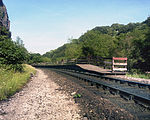Blackwell in the Peak

Blackwell is a village in the Derbyshire Dales local government district of Derbyshire, England, on the A6 main road between Bakewell and Buxton.It is sometimes referred to as "Blackwell-in-the-Peak" to distinguish it from Blackwell near Alfreton. It lies on the River Wye on the edge of the carboniferous limestone of the White Peak. Nearby is Blackwell Hall in the grounds of which have been found neolithic remains, including a flint resharpening flake for tranchet axes. There are also the remnants of a Romano-British field system, dating from around the year 400. The name is said to derive from the Norman Blacheuuelle or King's land. Jedediah Strutt had a farm there. About a mile (1.6 km) to the north west is Blackwell Mill, with the remains of the Midland Railway line from Millers Dale.
Excerpt from the Wikipedia article Blackwell in the Peak (License: CC BY-SA 3.0, Authors, Images).Blackwell in the Peak
Derbyshire Dales
Geographical coordinates (GPS) Address Nearby Places Show on map
Geographical coordinates (GPS)
| Latitude | Longitude |
|---|---|
| N 53.245 ° | E -1.813 ° |
Address
SK17 9TQ Derbyshire Dales
England, United Kingdom
Open on Google Maps











